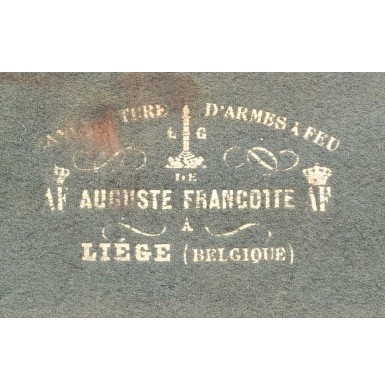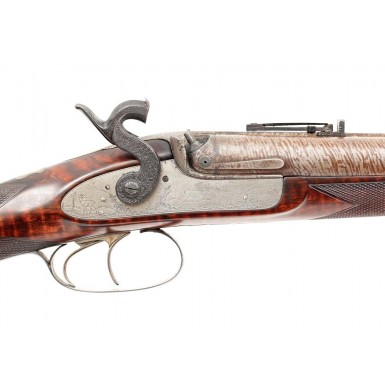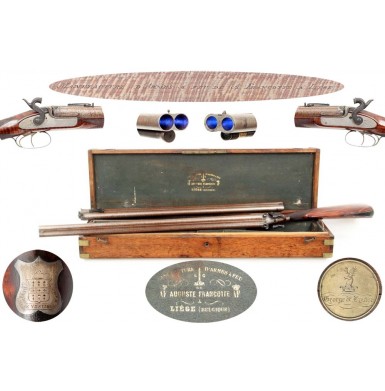Auguste Francotte Double Rifle-Shotgun Cased Set
- Product Code: FLA-2887-SOLD
- Availability: Out Of Stock
-
$1.00
This is a lovely cased Percussion Double Rifle / Shotgun by Auguste Francotte of Li’ge, Belgium. For the sportsman, the ultimate sporting gun is a two-barreled set with both double-rifle shotgun barrels, allowing the hunter to use the same stock and action for everything from game to wing shooting. This allows the shooter to become used to one stock, action and trigger pull that is consistent throughout, but also have a wide variety of loads and potential targets available for the same gun. The firm of Auguste Francotte & Cie was one of the premier firearms manufacturers in Belgium from its inception around 1805, through the beginning of the First World War. They produced a wide array of handguns, rifles and long arms, of both military and sporting patterns. The company was temporarily closed when Belgium fell to the Central Powers at the beginning of World War I. After World War I the firm was revitalized, and continued to produce high quality sporting arms and remained in business in Li’ge until the 1980s, when the firm went out of business. Today, the name Francotte lives on with a new company and is still associated with some of the finest sporting arms, with all arms being custom made, with an entry-level price for a shotgun being around $18,000! While this gun is not one of those 5-figure guns, it was certainly a high quality sporting gun set when Francotte originally produced by it.
The cased two-barrel set includes a side-lock receiver, mated to a pair of side-by-side barrels. The percussion rifle/shotgun set appears to have been manufactured sometime in the 2nd half of the 19th century, but I cannot pinpoint the date specifically. I would reasonably guess that the set was manufactured between about 1855 and 1875, so I will call the gun circa 1865 (+/- 10 years). The rifled barrel set is 29” long and is approximately .58 caliber. The bores are rifled with 3 wide, shallow grooves with a relatively fast rate of twist that almost makes a complete turn in the length of the barrels. The barrels have a full rib with a ladder rear sight and a removable front sight blade. The rear sight has a 100-yard fixed base blade, and the ladder is adjustable from 200 to 900 yards. The top rib of the barrel is engraved in a single line: MANUFACTURE D’ARMES A FEU DE A FRANCOTTE A LI’GE (A Francotte Manufacturer of Firearms of Li’ge). The bottom of the rifle barrels are marked with the usual array of Li’ge proof and makers marks. The left barrel is stamped E / LG / * within an oval proof mark and with the Belgian Perron viewers’ mark. The left barrel is also marked with a (CROWN / R indicating “rifled bores). The “R” mark was adopted in 1852 and the other previously mentioned proofs have been in constant use in Li’ge since 1853, and continue to be used for black powder arms produced there. Both barrels have deeply stamped (CROWN) /AF within an oval, indicating Auguste Francotte, and both breaches bear a (CROWN) / X inspection mark. The underside of the barrel rib is marked AB. The shotgun barrels are marked in the same way, both top and bottom, with the exception of the Crowned “R”, which is not present on the smoothbore barrels. The shotgun barrels are also nominally 29” in length, with muzzle diameters that measure about .685”, the modern equivalent of a 12-gauge with a full choke. The action is a conventional splinter forend with a pair of percussion side locks that are lightly engraved with game scenes of deer. The pair of locks are controlled by a pair of triggers, creating a completely redundant and independent set of firing actions, that allow one lock to fire even if the other lock or trigger fails. The hammers are scroll engraved with a floral motif and the hammer screws are engraved to match. Additional game scenes are present on the triggerguard bow, and triggerguard extensions forward and to the rear of the bow are engraved with floral motifs. The serial number No 2459 is engraved on the rear tang of the triggerguard. The same floral motifs from the trigger guard plates are continued on the single ramrod entry pipe at the tip of the forend, as well as on the escutcheon and wedge that secure the barrels, and on the tang of the buttplate. The length of pull for the front trigger is 14 ““ and the length of pull for the rear trigger is 13 “. The stock is made of highly figured walnut and is very attractive. It is expertly checkered at the wrist and on the forend, forward of the locks, at approximately 20 lines per inch. The wrist is set with a sliver plated shield shaped escutcheon that is engraved with a crowed shield shaped coat of arms topped by a stag’s head. The underside of the shield is engraved with the Latin motto: RETINENS VESTIGIA FAMAE in a ribbon surrounding the lower half of the shield and its bottom. This Latin phrase has many translations (none literal), but “retracing the footsteps of fame” or “the achievements of an honorable ancestry” seem to be the clearest. This phrase, and the coat of arms are that of the Lyster family (often modernized and Americanized to “Lister”), which has its origins in the Anglo-Saxon tribes of England. The name is derived from the old English term for a person who worked in dying trade, a “lister”. The earliest English recording of the name is in Yorkshire, and it is still a common surname in that area. The round brass escutcheon on the top of the casing is engraved with the same stags head and is engraved in gothic style GEORGE H LYSTER, although I may be misreading the “H” and it might be an “F”, due to the superfluous Gothic adornments to the letter. It might be possible to determine who George Lyster was, and by doing so establish the actual production date of the gun. The action and the two barrels are contained in the original Auguste Francotte casing. The case is a two level design, with the tray that holds the action and some of the accouterments being removable, revealing a second level of compartments to house the necessary tools and accessories for the maintenance and operation of the gun. The rear 1/3 of the case is dedicated to the barrels, which stack one on top of the other, with removable blocks that keep them correctly oriented and keep the barrels from banging against each other. The case is lined in green baize and has Fancotte’s retailer logo embossed on the inside of the lid in gold leaf. The retailer label reads: MANUFACTURE D’ARMES A FEU (Manufacturer of Firearms) in an arc over the Liege Perron symbol, which is flanked by the letters L and G. Below the Perron are a pair of (CROWN) / AF trademarks that flank DE / AUGUSTE FRANCOTTE over A / LI’GE (BELGIQUE) (Auguste Francotte of Li’ge, Belgium). The case is devoid of any accessories other than a single wooden handled tool, the purpose of which is not clear to me, and is probably related to reloading.
Overall, this Cased Auguste Francotte Double Rifle / Shotgun Combination is in about VERY GOOD as restored condition. The barrels have been carefully and professionally re-browned with a striped finish that is intended to look like a Damascus twist pattern, a typical finish on 19th century sporting arms. The rifle barrels retain about 80% of this restored finish, with most of the fading and loss at the muzzles and the breech. The metal of the barrels is almost entirely smooth, and the engraved retailer information on the top rib remains crisp and clear. There is some scattered pinpricking around the muzzles and breech area of the barrels, and some small patches of more prominent surface roughness and light pitting, mostly on the underside of the barrels at the breech. The barrels also show some scattered areas of lightly oxidized age staining and discoloration. The bores of the rifle barrels rate about VERY GOOD and retain strong rifling. The bores are mostly bright, with evenly scattered light pitting along their entire length, mixed with a few minor patches of more moderate pitting. The bores look like they would still shoot well today. The bolsters both retain what appear to be their original cones (nipples). The rear sight appears to be original as well, although it has been refinished with a hot immersion blue. The replaceable front sight blade appears to be original as well, and has also been reblued. The three steel thimbles under the barrel secure an ebony ramrod, which appears to be original to the gun. The rod has a brass jag style rammer head and a removable brass cap on the opposite end that reveals a threaded ball puller. The shotgun barrels retain about 85%+ of their restored finish, with most of the fading and loss at the muzzles and the breech, as with the rifle barrels. The metal of the barrels is almost entirely smooth, and the engraved retailer information on the top rib remains quite crisp and clear. There is some scattered pinpricking around the muzzles and breech area of the barrels, and some small patches of more prominent surface roughness and light pitting, mostly on the underside of the barrels at the breech. The barrels also show some scattered areas of lightly oxidized age staining and discoloration. The shotgun bores rate about VERY GOOD+ and are fairly smooth throughout. The bores are mostly bright, with some evenly scattered light pitting along their entire length, mixed with a few minor patches of more moderate pitting. The bores look like they would still shoot well today, and would probably benefit from a good cleaning and a light polishing. The cones (nipples) in both bolsters appear to be more modern replacements. What appears to be the original brass bead front sight is present on the top of the rib, near the muzzles. What appears to be the original ebony ramrod is secured by the three steel thimbles under the barrel. The rod has a brass rammer head and a removable brass cap on the opposite end that reveals a threaded charge puller that is smaller and lighter than the puller on the end of the rifle rod. The action of the gun remains in excellent mechanical condition and both locks operate crisply and flawlessly. The lock plates were cleaned to bright steel at some point in time and are starting to tone down to a medium pewter patina. Both lock plates show even light pitting over all of the their surfaces, some of which is very tiny pinprick style and some of which is somewhat more aggressive. The pitting on the right lock is much smaller and less intrusive than on the left lock. The left lock shows moderate pitting under the bolster area, with some metal erosion and loss of engraving. The hammers both appear to be original to the gun and show wear commensurate with the condition of the locks, especially inside the hammer faces. The hammers have been reblued with the same hot immersion blue used on the sights. The front extension of the triggerguard, the entry pipe that caps the forend of the stock and the barrel wedge and its escutcheon, have all been cleaned to bright steel, like the locks, and are now toning to pewter. They all show even pricking over their surfaces. The triggerguard bow and the triggerguard tang have been reblued and match the hammers and the sights. The triggerguard and the tang retain about 90%+ of this restored blue finish. Most of the screws on the gun have been reblued as well to match the other refinished components. The buttplate has been reblued as well, but only retains about 50%+ of that finish with wear and fading noted from handling and use. The buttplate also shows some scattered light pitting and some patches of surface roughness. The buttstock of the gun remains in about FINE condition as lightly refinished. The stock does not appear to have been sanded, but does appear to have some lightly added oil finish. It appears that the stock may have had some mold on it at one time, as there are a few scattered areas on both sides of the butt with some dulling to the finish. This could likely be remedied with a little light cleaning and some good oil. The checkering appears to be original and unmolested. It remains fairly crisp, but there is some light wear and loss of sharpness visible under magnification. There is no indication that the checkering has been re-cut or “freshened”. The fore end is in the same overall condition as the buttstock, with equally nice checkering. The stock is solid and complete with no breaks, cracks or repairs noted. As usual, there are some lightly scattered handling marks, but nothing worth noting. The casing is original of the gun and fits it very well. The case appears to be oak, is brass bound with corner reinforcements, and is in about GOOD+ condition. The case shows significant wear and use as well as some abuse. The lid has a significant crack separating two of its panels, and several small nails have been used to shore up and reinforce the lid over the years. The case shows numerous bumps, dings, cracks, etc., over its exterior and interior. The green baize lining appears to be original, but is very well worn with staining, small rips, small tears and numerous wear marks throughout. The lining also shows evidence of mildew (and possibly mold) suggesting that the entire suite was poorly stored in a damp location for some time. The compartment dividers vary in condition from very good to only fair, with some in decent shape and quite sturdy and some very well worn and barely remaining in place in the case. The removable upper deck that holds the action of the gun is in good solid condition, with only some of the dividers showing weakness and serious wear. The three brass hinges that secure the lid appear to be original, and the original brass lid stop is present, but has pulled out of the casing and is no longer working. The brass escutcheon for the lock is missing from the front of the case and the key is missing as well. As mentioned above, the brass disc on the top of the case is engraved with a name and part of the coat of arms of the former owner of this sporting arms set.
Overall this is a rather attractive, if somewhat poorly stored late 19th century 2-barrel percussion sporting set. It appears that the pitting on the locks and furniture is from poor storage in damp location, but thankfully the damage was only cosmetic as the lock remain very crisp and the barrels seem no worse for the wear. Both sets of barrels are very attractive as professionally restored and only the exterior of the locks and furniture might need some more restorative work to remove the hot blue c1950 and make the gun set look even better. For the dedicated black powder hunter, this would be a great set to go afield with for game or fowl. It would be a good project for the collector who would like to restore the case to its former glory and attempt to find a group of appropriate accouterments to repopulate the compartments with. For the collector, this is a very reasonably priced example of a fine Belgian double rifle/shotgun set that allows you to get involved in the collecting of 19th century sporting arms without going anywhere near the 5-figure point where most cased 2-barrel sets start. However, I think this gun would be most at home out in the field, where the fine locks and good barrels can be put back to use harvesting deer and birds during traditional hunting season.
Please note, due to size and weight, extra shipping charges will apply, or you can arrange to pick up the set at a show that I am attending. SOLD
Tags: Auguste, Francotte, Double, Rifle, Shotgun, Cased, Set














